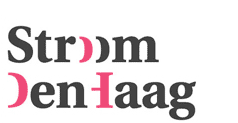Stroom Bibliotheeksessies: Peter Bil’ak
Wednesday 3 December 2014Location: library Stroom Den Haag, Hogewal 1-9, The Hague
Archive Stroom Bibliotheeksessies/library sessions
Graphic designer Peter Bil'ak was the special guest for the Stroom Library Session on Wednesday December 3th. That afternoon we spoke, with a small group of selected guests, about his multifaceted work as a designer of typefaces, dance performances, signages for the new Paris metro network, and his involvement in the magazines Dot Dot Dot and Works That Work. Peter proved to be a very inspiring strategy-maker who allowed us a deep insight in the backgrounds of his amazing projects.
Peter Bil'ak was educated at the Jan van Eyck Academie in Maastricht, and started to work as a graphic designer for Dumbar Studio in The Hague in 1999. In 2001 he set up his own studio, Typotheque, the base from which he works successfully as an independent designer, together with his wife Johanna.
At the Jan van Eyck Academie he met the artist Johan Grimonprez for whom he designed the Dial H-I-S-T-O-R-Y book, and graphic designer Stuart Bailey, who was then the first, and for some time only, student of Karel Martens at the Werkplaats Typografie in Arnhem. Martens took Stuart with him to Maastricht on his teaching trips to the Jan van Eyck. Soon after meeting Peter and Stuart started the unruly graphic design magazine Dot Dot Dot in 2000, which became the antithesis of the glossy design magazines that were on the market at that time. It's success was partly based on the opaqueness of the content, an often used phrase to compliment the editors was: "I didn't understand it, but I loved it!" This began to bother Peter, because in his work he really wants to involve the user. He felt that operating in the subsidized art world was too limiting, paradoxically because of its freedom: it made you care less about the effects of your work.
In 2012 Bil'ak started his own magazine Works That Work, and specially for this session Peter brought with him the latest issue, fresh from the printers, dealing with manifestations of unexpected creativity triggered by extreme living conditions around the globe. He talked about all the stories that he wants to learn more about and the networks of correspondents he plugs into on the internet. He also discussed the experimental business model for publishing a small periodical. The way that he distributes the magazine around the world bypasses the middleman. There is a direct line between maker and reader, a community of directly involved readers distributes the magazine amongst friends and interested others.
Peter Bil'ak's bag of books
For this session Peter brought several books and magazines that he made or that have inspired him. First he showed a copy of The International New York Times, and a copy of The National Geographic. Both are not typical art or design media, but in them he finds stories that trigger his curiosity, and they give him the opportunity to learn more about unexpected things.
Dot Dot Dot No. Six/ edited by Peter Bil'ak and Stuart Bailey. - The Hague, October 2003
contains the following articles:
A Proposal by Ken Garland; Loose Associations by Ryan Gander; Zang Tang Tumb by Experimental Jetset; Mike Figgis: Rushes from ‘In the Dark' by Mike Figgis/Stuart Bailey; A Field Guide by David Reinfurt; Bauhaus Yoga by Paulina Olowska; History of a New Font by Peter Bilak; Now in Full Colour by James Goggin; Interior View by Claire Bartoli; C-JLG-A: Archive/Text/Quotation - CinÉphile/Critic/CinÉaste by Esther Johnson; Soft Modernist: Discovering the Book Covers of Fred Troller by Mark Owens; The Typographer's Widow by Kapil Kachru; Fuck Heroes (I Believe in Heroes)
by Dmitri Siegel
Works That Work #4 / edited by Peter Bil'ak. - The Hague, November 2014
If necessity is the mother of invention, extreme environments must be hotbeds of innovation.
There are fertile lands in warm climates that have just enough sunshine and rainfall to create ideal conditions for human life. But as populations grow and competition for resources increases, communities press outward into less-ideal areas, braving extremes of heat and cold, sunlight and darkness, striking out into the farthest, most isolated places they can reach. There are, of course, many other kinds of extreme environments, and so we expanded our research to include war zones, deserts, non-residential buildings and even outer space, looking for the innovations that make life possible even in those places. But as fascinating as it was to explore tools and architectural particularities, ultimately the real reward was in the human stories we encountered, stories of how overcoming hardship creates tight communities and awakens the potential in each of us.
ABECEDA [Alphabet] / written by Vitĕzslav Nezval, design by Karel Teige. - Czechoslovakia, 1923. - 30.5 x 47cm. - Illustrated with 25 black and white photomontages.
The 1926 book Alphabet (Abeceda) is a landmark achievement in European modernism. Its frequent reproduction in exhibition catalogues and scholarly articles has made it a key symbol of Devetsil (1920-ca. 1931), the Czech artists' collective within whose ranks the book was conceived, and its importance is increasingly measured in international terms as well. The book consists of a series of rhymed quatrains by Devetsil poet Vitezslav Nezval, titled and ordered according to the letters of the Latin alphabet. Facing each set of verses is a Constructivist photomontage layout by Karel Teige, a painter turned typographer who was also Devetsil's spokesperson and leading theorist. Teige developed his graphic design around photographs of dancer and choreographer Milada (Milca) Mayerova, a recent affiliate of the group, who had performed a stage version of "Alphabet" to accompany a recitation of the poem at a theatrical evening in Nezval's honor in April 1926.
"In Nezval's Abeceda, a cycle of rhymes based on the shapes of letters, I tried to create a 'typofoto' of a purely abstract and poetic nature, setting into graphic poetry what Nezval set into verbal poetry in his verse, both being poems evoking the magic signs of the alphabet." -Karel Teige
Dial H-I-S-T-O-R-Y / by Johan Grimonprez, design by Peter Bil'ak. - Brussels : Argos, 2002
Dial H-I-S-T-O-R-Y, a 68 minute-long film by director Johan Grimonprez, traces the history of airplane hijackings as portrayed by mainstream television media. In his film Grimonprez focuses on the imbalance of power between the way artists understand themselves to be ‘radical' and the way terrorists apprehend the same word. Artists consistently fail to be ‘dangerous' in the sense that terrorists are. Compared to the bomb-makers of this world, artists - and writers too - are powerless he admonishes.
In contrast to the video, the contents of the book does not show any of the planes hijacked, but focuses on the stories of the people involved, those often forgotten in the light of the spectacular.
Inflight magazine / Johan Grimonprez. - 128 pages ; Ostfidern : Hatje Cantz Publishers (October 2, 2000) ISBN-13: 978-3775709934
Anyone who's ever sat on airplane has looked at them at least once--the safety instructions pamphlets and glossy airline magazines provided for the passenger's edification and entertainment. Inflight Magazine puts a sinister and subversive twist on these banal booklets--formally presented as a magazine, it functions as an artistic manual for hijackers, equipped with such essentials as a safety instruction card and a sick bag. What could be played as a simple joke serves for Belgian artist Johan Grimonprez as an illumination of the value of the spectacular in our culture of catastrophe. Inflight Magazine denounces the media pseudo-event, attempting to reveal the influence of pictures on our feelings, perception and memory. Viewers and readers are taken onto a jarring flight through their own experiences, memories and emotions, allowing them to create a space of critical distance from the spectacle of the media. The publication of Inflight Magazine accompanies a traveling exhibition around the world, with stops in Ghent, New York, Copenhagen, Athens, Berlin, Oslo, Cambridge, and Brussels.
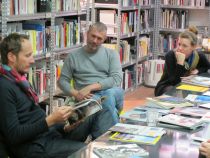
Stroom library session Peter Bil’ak
foto: Stroom Den Haag
foto: Stroom Den Haag
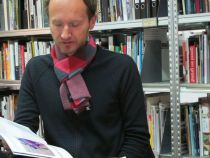
Stroom library session Peter Bil’ak
foto: Stroom Den Haag
foto: Stroom Den Haag
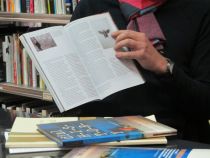
Stroom library session Peter Bil’ak
foto: Stroom Den Haag
foto: Stroom Den Haag
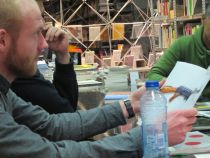
Stroom library session Peter Bil’ak
foto: Stroom Den Haag
foto: Stroom Den Haag
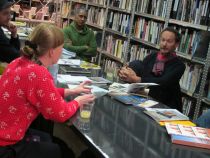
Stroom library session Peter Bil’ak
foto: Stroom Den Haag
foto: Stroom Den Haag
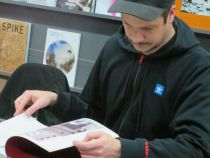
Stroom library session Peter Bil’ak
foto: Stroom Den Haag
foto: Stroom Den Haag
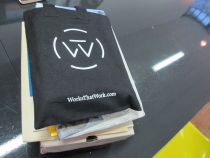
Peter Bil’ak's bag of books
foto: Stroom Den Haag
foto: Stroom Den Haag
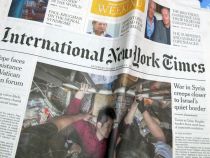
The New York Times
foto: Stroom Den Haag
foto: Stroom Den Haag
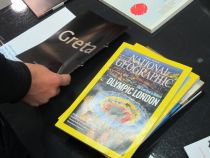
The National Geographic
foto: Stroom Den Haag
foto: Stroom Den Haag
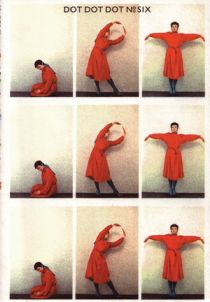
Dot Dot Dot
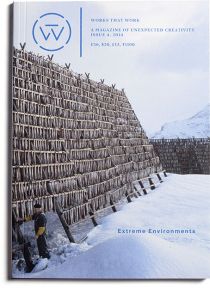
Works that Work
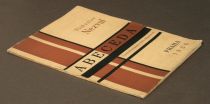
ABECEDA [Alphabet]
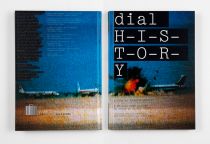
Dial H-I-S-T-O-R-Y
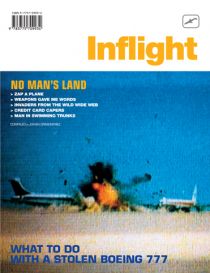
Inflight magazine

















